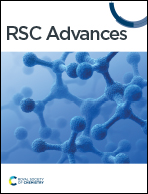Synthesis of efficient bi-anchoring bifuran/biphenyl derivatives for dye-sensitized solar cell applications†
Abstract
The synthesis, description, and demonstration of dye-sensitive solar cell sensitizers containing bifuran/biphenyl derivatives with cyanoacetic acid, barbiturate, thiobarbituric acid, and 4-carboxylcyanoacetamides have been reported. A photovoltaic performance measurement was conducted using the Ru(II) dye N3 as a reference to examine the effects of different electron acceptor units and replacement of the π-spacer bifuran by biphenyl units on the photophysical, electrochemical, and photovoltaic properties of eight new distinct organic dyes HB-1–8. The new organic dyes HB-1–8 were prepared and compared with the N3 metal dye. Density functional theory calculations were carried out to explore the ground state geometrical structures and electronic structures of the eight dyes. Under standard global AM 1.5 solar condition, the solar cells based on HB-1–8 show the overall power conversion efficiencies of 2.93–5.51%. The presented research shows that the organic dye photovoltaic performances can vary greatly depending on the type of electron donor and acceptor used. Dye HB-3 exhibited the highest efficiency among the eight investigated dyes, reaching 5.51% with a VOC value higher than N3.



 Please wait while we load your content...
Please wait while we load your content...